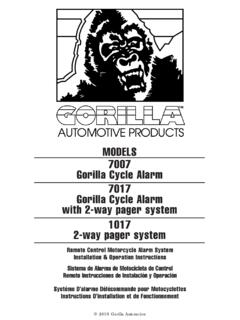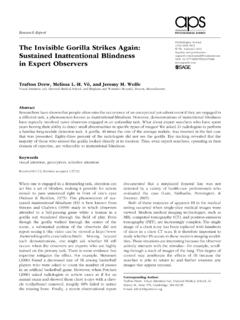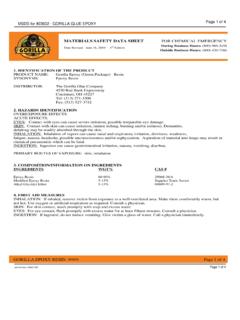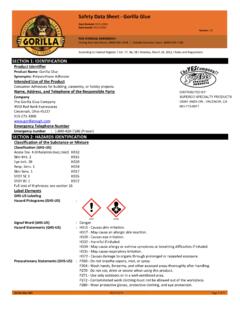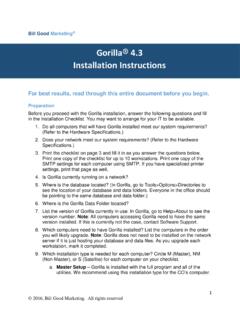Transcription of GORILLA -SNOT SAFETY DATA SHEET - Soilworks
1 USA Intl SGS1507021 | GORILLA -SNOT SAFETY data SHEET 1 of 8 Revised: 9/3/2020 It s Snot Just Water GORILLA - SNOT SAFETY data SHEET SECTION 1 IDENTIFICATION PRODUCT NAME GORILLA -SNOT Soil Stabilizer & Dust Control Agent CHEMICAL FAMILY Synthetic Copolymer Dispersion MANUFACTURER Soilworks , LLC Soil Stabilization & Dust Control 11520 E Germann Rd Chandler, Arizona 85286 USA (800) 545-5420 USA +1 (480) 545-5454 International EMERGENCY PHONE NUMBERS (800) 545-5420 USA +1 (480) 545-5454 International data UNIVERSAL NUMBERING SYSTEM (DUNS NUMBER) Soilworks , LLC 131946159 DEPARTMENT OF DEFENSE COMMERCIAL AND GOVERNMENT ENTITY CODE (CAGE CODE) Soilworks , LLC 3 FTH5 DEPARTMENT OF DEFENSE NATIONAL STOCK NUMBERS (NSN) 275-gallon (1,041 Liter) Intermediate Bulk Container (IBC) Tote 6850-01-542-5389 55-gallon (208 Liter)
2 Drum 6850-01-542-3712 GENERAL SERVICES ADMINISTRATION (GSA) CONTRACT Soilworks , LLC GS-07F-5364P October 31, 2018 SYNONYMS/OTHER MEANS OF IDENTIFICATION GORILLA -SNOT is a formulated, high molecular weight, engineered, prime synthetic copolymer dispersion. INTENDED USES For industrial use only. Major industries include construction, mining, military, municipal, oil & gas, energy & renewable energy and transportation. Abate dust, air quality control, control dust, controlling dust, desertification prevention, dune stabilization, dust abatement, dust control, dust control agent, dust control material, dust control product, dust elimination, dust inhibitor, dust mitigation, dust palliative, dust pollution control, dust pollution prevention, dust prevention, dust reduction, dust retardant, dust stabilization, dust stabilizer, dust suppressant, dust suppression, eliminate dust, erosion control, erosion control material, erosion control product, erosion prevention, fines preservation, fugitive dust control, hydromulch tackifier, hydroseed tackifier, inhibit dust, mitigate dust, pm10 control, control, prevent dust, reduce dust, retard dust, road stabilization, road stabilizer, sand stabilization, soil additive, soil amendment, soil binder.
3 Soil crusting agent, soil solidifier, soil stabilization, soil stabilizer, stabilize dust, stabilize soil, stockpile capping, stop dust, suppress dust, surface wear course, wind erosion control. USA Intl SGS1507021 | GORILLA -SNOT SAFETY data SHEET 2 of 8 Revised: 9/3/2020 It s Snot Just Water SECTION 2 HAZARDS IDENTIFICATION Emergency Overview Appearance: Milky white liquid (transparent once cured) Odor: Sweet and mild (no odor once cured) Health Hazards: Under normal conditions of industrial use, this material is NOT expected to be a primary route of exposure SAFETY Hazards: Nonflammable Environmental Hazards: NOT classified as dangerous for the environment HEALTH HAZARDS INHALATION Under normal conditions of industrial use, this material is NOT expected to be a primary route of exposure SKIN CONTACT Under normal conditions of industrial use, this material is NOT expected to be a primary route of exposure EYE CONTACT Under normal conditions of industrial use, this material is NOT expected to be a primary route of exposure INGESTION Under normal conditions of industrial use, this material is NOT expected to be a primary route of exposure GLOBALLY HARMONIZED SYSTEM OF CLASSIFICATION AND LABELLING OF CHEMICALS (GHS) Not a hazardous substance or mixture HAZARDOUS MATERIALS IDENTIFICATION SYSTEM (HMIS)
4 RATING Health 0 No significant risk to health Flammability 0 Material will not burn Physical Hazard 0 Stable, non-reactive and non-explosive Personal Protection - No special hazard under normal use SECTION 3 COMPOSITION/ INFORMATION ON INGREDIENTS This material does NOT contain hazardous ingredients and is NOT considered hazardous according to OSHA criteria. # COMPONENT % CAS Number 1. Synthetic Vinyl Copolymer Dispersion 60-20% Non-Hazardous 2. Water 40-80% 7732-18-5 SECTION 4 FIRST-AID MEASURES Provide medical care provider with this SAFETY data SHEET . EYE CONTACT If irritation or redness develops from exposure, flush eyes with clean water. If irritation persists, seek medical attention. SKIN CONTACT No treatment necessary under normal conditions of use. Remove contaminated clothing. Wash affected area with mild soap and water.
5 If irritation or redness develops and persists, seek medical attention. INHALATION No treatment necessary under normal conditions of use. If breathing difficulties develop move victim away from source of exposure and into fresh air in a position comfortable for breathing. If symptoms persist, seek medical attention. INGESTION If swallowed do not induce vomiting. If symptoms persist, seek medical attention. USA Intl SGS1507021 | GORILLA -SNOT SAFETY data SHEET 3 of 8 Revised: 9/3/2020 It s Snot Just Water SECTION 5 FIRE-FIGHTING MEASURES FLAMMABILITY Nonflammable and NOT combustible This material is an aqueous mixture that will not burn Dried material will burn in a fire FLASH POINT Nonflammable EXTINGUISHING MEDIA Use water spray, foam, dry chemical or carbon dioxide SPECIAL FIRE FIGHTING PROCEDURES & PROTECTIVE EQUIPMENT Cool closed containers exposed to fire with water spray.
6 Proper protective equipment including breathing apparatus must be worn when approaching a fire in a confined space. NATIONAL FIRE PROTECTION ASSOCIATION (NFPA) 704 HAZARD CLASS SECTION 6 ACCIDENTAL RELEASE MEASURES For guidance on selection of personal protective equipment see Chapter 8 of this SAFETY data SHEET . See Chapter 13 for information on disposal. Observe the relevant local and international regulations. PROTECTIVE MEASURES Stop the leak, if possible. Avoid contact with skin and eyes. Use appropriate containment to avoid environmental contamination. Prevent from spreading or entering drains, ditches, sewers, rivers or open bodies of water by using sand, earth or other appropriate barriers. CLEAN-UP METHODS Avoid accidents, clean up immediately. Slippery when spilled. Prevent from spreading by making a barrier with sand, earth or other containment material.
7 Reclaim liquid directly or in an absorbent. Soak up residue with an absorbent such as clay, sand or other suitable material and dispose of properly. ADDITIONAL ADVICE Local authorities should be advised if significant spillages cannot be contained. SECTION 7 - HANDLING AND STORAGE GENERAL PRECAUTIONS Use local exhaust ventilation if there is risk of inhalation of vapors, mists or aerosols. Use the information in this data SHEET as input to a risk assessment of local circumstances to help determine appropriate controls for safe handling, storage and disposal of this material. Legend 0 Minimal 1 Slight 2 Moderate 3 Serious 4 Severe USA Intl SGS1507021 | GORILLA -SNOT SAFETY data SHEET 4 of 8 Revised: 9/3/2020 It s Snot Just Water STORAGE Keep container tightly closed in a cool, well-ventilated place.
8 Use properly labelled and closeable containers. Maintain storage temperature 40 F (4 C) to avoid freezing and destabilization. Ideal storage temperature is 72 F (22 C). HANDLING Avoid breathing vapors or mist. Avoid contact with eyes. Avoid prolonged or repeated contact with skin. Wash thoroughly after handling. When handling material in drums, SAFETY footwear should be worn and proper handling equipment should be used. RECOMMENDED MATERIALS For containers or container linings, use mild steel or high density polyethylene. ADDITIONAL INFORMATION Do not freeze. SECTION 8 EXPOSURE CONTROLS / PERSONAL PROTECTION OCCUPATIONAL EXPOSURE LIMITS Contains no substances with occupational exposure limit values. EXPOSURE CONTROLS The level of protection and types of controls necessary will vary depending upon potential exposure conditions.
9 Select controls based on a risk assessment of local circumstances. Appropriate measures include: Adequate ventilation to control airborne concentrations. Where material is heated, sprayed or mist formed, there is greater potential for airborne concentrations to be generated. PERSONAL PROTECTIVE EQUIPMENT Personal protective equipment (PPE) should meet recommended national standards. Check with PPE suppliers. RESPIRATORY PROTECTION Respiratory protection is NOT required under normal conditions of use in a well-ventilated workplace. In accordance with good industrial hygiene practices, precautions should be taken to avoid breathing of material. If engineering controls do not maintain airborne concentrations to a level which is adequate to protect worker health, select respiratory protection equipment suitable for the specific conditions of use and meeting relevant legislation.
10 Check with respiratory protective equipment suppliers. Where air-filtering respirators are suitable, select an appropriate combination of mask and filter. Select a filter suitable for combined particulate/organic gases and vapors. HAND PROTECTION Where hand contact with the material may occur the use of gloves approved to relevant standards ( Europe: EN374, US: F739) made from the following materials may provide suitable chemical protection: PVC, neoprene or nitrile rubber gloves. Suitability and durability of a glove is dependent on usage, frequency and duration of contact, chemical resistance of glove material, glove thickness, dexterity. Always seek advice from glove suppliers. Contaminated gloves should be replaced. Personal hygiene is a key element of effective hand care. Gloves must only be worn on clean hands. After using gloves, hands should be washed with soap and water and dried thoroughly.
